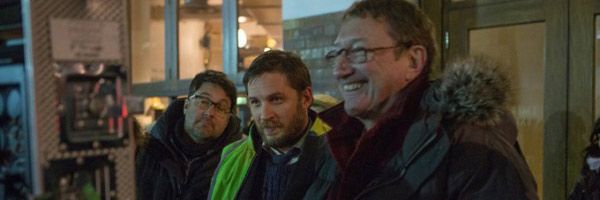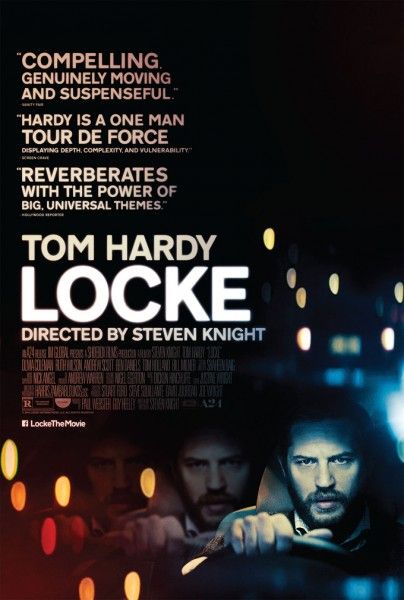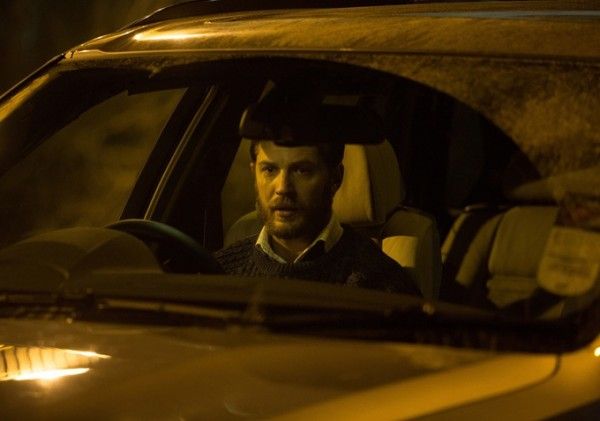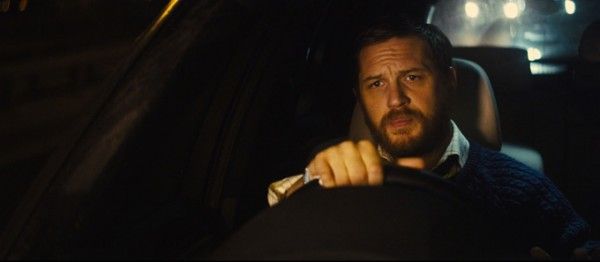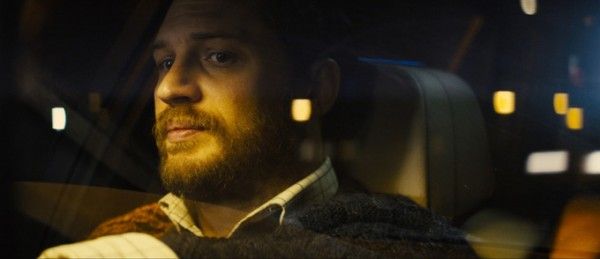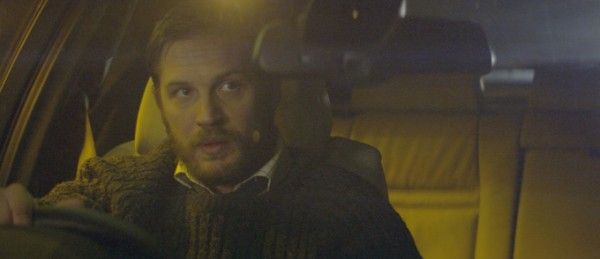Written and directed by acclaimed filmmaker Steven Knight and driven by an unforgettable performance by Tom Hardy, Locke is an exploration of how one decision can lead to the complete collapse of a life. On the eve of the biggest challenge of his career, Ivan Locke (Hardy) receives a phone call that sets in motion a series of events that will unravel his family, job and soul even as he fights to salvage all that is important to him. Opening April 25th, the film also features Olivia Colman, Ruth Wilson and Andrew Scott.
In an exclusive interview, Knight spoke about wanting to direct a film where all the action takes place over the course of one absolutely riveting car ride, what Hardy brought to the unusual role, what inspires their continued collaboration, how the entire film was shot at night within a short two-week window, how he sustained the pace and kept it visually dynamic while the main character’s life was unraveling in real time, and his cool upcoming projects including The Hundred-Foot Journey with Helen Mirren, Pawn Sacrifice with Tobey Maguire, a second season of the Peaky Blinders gangster series, and Taboo, an 8-episode drama for the BBC executive produced by Ridley Scott. Check out the full interview after the jump:
Question: How did this project first come together for you? When you were writing this, did you always plan to direct?
STEVEN KNIGHT: Yes. I’d just finished directing a more conventional film (Hummingbird), and I was wondering if there were other ways of doing the same thing, which is getting people into a room, turning off the lights, and getting them to engage with the screen. Along the way, in editing the other film, I watched a lot of test footage from cameras in urban situations from moving vehicles, and I thought it was beautiful. It looked like an installation. At first, I thought that could be it. You could do this and have it as an installation – a big, beautiful picture of lights. I thought well maybe that could be the theater and you put an actor into that theater and shoot it as a play and have the other voices come in. These things started to occur to me, and then I thought we were going to need somebody really good. And so, I met Tom (Hardy) and put the idea to him and he loved it. Then I wrote the script after that. He loved the script and then we shot it. It all came together alarmingly quickly really.
What are the challenges of making a film where it stands and falls on the shoulders of one actor and it all takes place in one location?
KNIGHT: I’ve watched people watch the film quite a lot. The important thing is probably the novelty is there for the first five minutes. That’s okay. Then after that you’ve got to get them away from the novelty and into the story. You’ve got to have them worrying about the character. You’ve got to have them involved and engaged. And so, it was just trying to find the story that would get people to engage. When you’ve got Tom, you know that you’ve got the best possible actor to perform this, but you have to have something that’s happening on the screen that concerns people and that people are going to engage with. From the beginning, I didn’t want it to be a murder or a kidnapping or any of those things. I wanted it to be a completely ordinary tragedy, where it’s the end of the world for the people involved, but it’s not going to make the papers. It’s not going to make the local news. I wondered if you do that will people engage because they see something of themselves or their dad or their son, or something that is very familiar to them, and will that keep them going? The responses when the lights go up have been so emotional from people who’ve said, “That’s the journey my dad didn’t make. That’s the journey I should have made.” Hopefully, it works because people recognize situations that they’ve been in and see how someone works it out but in intimate detail. That’s why I think they don’t look away.
How do you sustain the pace and keep it visually dynamic and moving forward while at the same time the main character’s life is unraveling?
KNIGHT: There’s something fortunate about the fact that it’s a journey and you know where he’s going. In film terms, people talk about how the character must have his journey. In this, the journey is real and you know he’s making progress of sorts in the back of your mind. He’s getting closer to something. I think that helps. Haris (Zambarloukos), who is the director of photography, did a beautiful job on making everything look so gorgeous. When we discussed it, I said to him, “I’d love it if this is something you could turn the sound down and just look at and see this thing and the lights and the reflections. So, I think that helps as well in terms of that being the environment. But all of those things have to be secondary. The thing that matters is people have to worry about him and what’s happening to him, because otherwise it would be impossible to sustain.
You shot this in two weeks in the evenings. How did that work?
KNIGHT: All the actors apart from Tom were in a hotel conference room near to the motorway. We had a phone line open. It was a real phone line into the car. Tom was on the back of a low-loader truck. The vehicle had the wheels taken off so that it was at the right level. I was in front of him with visual contact and audio contact with him and also with the conference room, and the plan always was, and this is what we did, is to shoot the whole thing beginning to end every time. I would only say “Action” once, and then the vehicle would set off. I would cue the first call, then the second, then the third. Effectively, we shot the whole film twice a night. That would be the end. In the end, we had 16 movies, all pretty ragged, but they were 16 movies, and then we’d cut together the film that we wanted to make.
You must have had a very good editor?
KNIGHT: Oh fantastic. Justine (Wright) is brilliant.
You’ve collaborated with Tom before. What is it that he brought to this role and what do you see in him as an actor?
KNIGHT: I think he is the best actor that we have, we being Europe. I just think he’s so good and so adaptable, but at the same time, even though he can play a range of parts, there’s always the core which is a little bit unpredictable. The core of him is always there, and there’s nothing you can do. There are certain actors that are chameleons and that’s great. There are certain actors who are sort of John Wayne, and they’re always John Wayne. And that’s great because that’s fine. You just put them in the situations where you want that character. But Tom is both so he can do both. He’s always got the John Wayne, but he’s also very chameleon. He can also adapt to lots of different situations.
What did the supporting actors bring to the process?
KNIGHT: We got the best U.K. actors that there are. They all said yes because they were intrigued by the project and obviously wanted to work with Tom. We got Olivia Colman, Ruth Wilson and Andrew Scott who are the best you can get. What we were offering them was to sit in a conference room from 9:00pm to 4:00am with some biscuits and some red wine, and that was it. And then, I was cueing them through the night. At first, they thought we were mad, and then the third night I showed them some footage to say, “We’re not insane. This is how it looks. It’s going to be alright.” They were just so good. We did the read through around the table for five days, so that’s when we got who these people are and why they do what they do.
How does the final film compare to what you originally envisioned?
KNIGHT: Very close. Closer than anything I’ve ever done because the environment was so controlled. Tom didn’t want to go off script at all. He didn’t want to improvise at all which is great. And so, the auto cue is there in the rear view and it just means that he didn’t have to memorize 90 pages. It’s the script on a screen. Therefore, he was free to do what he does, and he does it so well. That meant that pretty much everything in the environment you could control. When you shoot a conventional film, things go wrong. It’s not the right location. It’s not how you imagined it. But this is one location that you could just completely control.
What did you learn about yourself personally or professionally in the process of making this?
KNIGHT: It confirmed something to me. Sometimes if you’re a director, you want to believe that you’re great and capable at all aspects – the technical side, the lights, everything -- but I’m not. I’ve realized that the only thing I’m interested in is the performance. If the performance is right, then I’m happy. You offer up the dialogue and then the performance comes around. If the performance is great, I’m happy completely. The question was: Would an audience also be happy? In other words, is it enough just to have the eyes of the actor as your point of focus? It’s not an explosion or a special effect. That’s it. It’s just his face. Is it enough? That is a genuine question because I didn’t know. But then, when we showed it in Venice and the lights went up, there was a fantastic response. There was just the word, “What?,” because Tom and I had no idea if it would work or not.
What are some of the cool projects that you have coming up that you’re excited for audiences to see?
KNIGHT: I’ve got a film called The Hundred-Foot Journey which is at DreamWorks with Helen Mirren which is out in August and a Tobey Maguire movie, Pawn Sacrifice, about Bobby Fischer which is shot and cut and will be out I think in autumn. I’m writing a few interesting things as well.
Aren’t you working with Tom right now on a second season of Peaky Blinders?
KNIGHT: Yes, I’ve written a second season of Peaky Blinders and it’s been shot. He’s brilliant. He’s shot his part for that and it’s looking fantastic.
Isn’t he also attached to Taboo, an 8-episode drama you’re doing for the BBC?
KNIGHT: Yes. Taboo is coming up with Ridley Scott who is executive producing. (Laughs) There’s a lot going on here.

